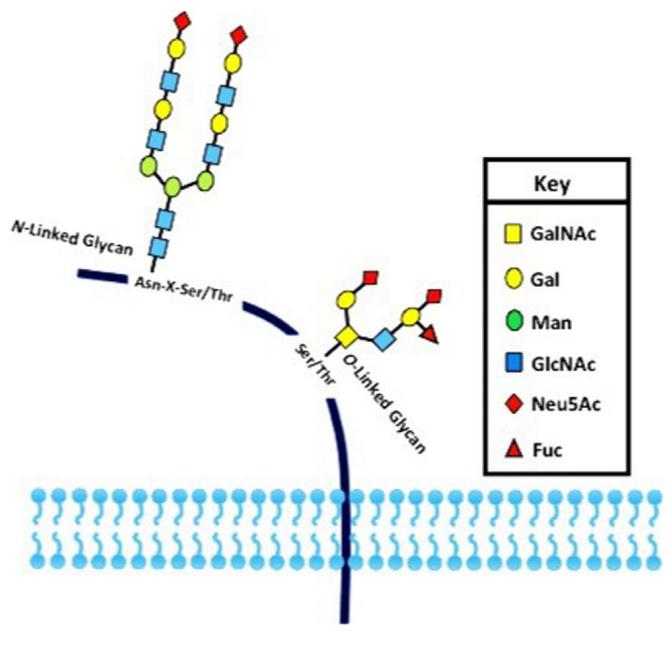A New Method of Engineering Glycoprotein Biosynthesis in Bacteria
Protein glycosylation
Protein glycosylation is the most abundant and complex type of protein post-translational modification. It is the process in which glucose is transferred to proteins and particular amino acid residues on proteins under the action of glycosyltransferases to form glycosidic bonds. As a result of glycosylation, different proteins are marked differently, changing the polypeptide's conformation, and increasing the protein's stability. Protein glycosylation plays a vital role in many biological processes, such as immune protection, virus replication, cell growth, cell-cell adhesion, and inflammation. Many proteins, such as transcription factors, heat shock proteins, nucleoporins, RNA polymerase II, oncogene translation products, enzymes, etc., are post-translational modifications such as glycosylation. There are two main types of glycosylation of proteins in mammals: N-glycosylation and O-glycosylation. Most glycoproteins contain only one kind of glycosylation; however, some protein polypeptides have N-glycan and O-glycan chains. Among them, O-glycoprotein mainly exists in mucus and immunoglobulin.
 Fig.1 The two major types of protein glycosylation.
Fig.1 The two major types of protein glycosylation.
Glycoconjugate vaccines
Vaccines play an important role in maintaining human health. The most eye-catching polysaccharide conjugate vaccine in the global market is undoubtedly the polysaccharide vaccine. The polysaccharide conjugate vaccine is prepared by coupling the bacterial surface polysaccharide with the carrier protein. After more than ten years of research, the immune process of glycoconjugate vaccines has been clarified. Because Polysaccharide conjugate vaccines can stimulate both T cell and B cell-mediated immune responses and are considered one of the most successful forms of bacterial vaccines. O-Antigen Polysaccharide (OPS) is an effective vaccine candidate. However, natural extraction or chemical synthesis of O-PS has high technical requirements, and the cost is high, but the efficiency is low.
The traditional production method of the glycoconjugate vaccine is a chemical method. Although this method is very mature, it still has many shortcomings: from the perspective of the preparation process, due to the multi-step purification involved, the yield is low, resulting in high production costs. The price is high, and the production process needs to be optimized urgently.
Engineering Glycoprotein Biosynthesis in Bacteria
For a long time in the past, researchers have always believed that there is no protein glycosylation modification in bacteria, but in recent years, with the discovery and in-depth research of glycoproteins and the continuous development of synthetic biology, a new type of biological preparation for Bacterial polysaccharide conjugate vaccine technology is gradually emerging. As an organism lacking an endogenous protein glycosylation modification pathway, E. coli is an ideal and promising chassis cell for orthogonalizing protein glycosylation modification.
Recently, researchers have found a new method that works on engineering bacteria to accomplish more tasks. This platform is based on attempting to engineer strains of E. coli to make human glycoproteins by inserting the appropriate human glycosyltransferase genome. Based on no natural protein glycoproteins pathways in E. coli, it made it possible to engineer strains that faithfully replicate existing glycoproteins or create systems that create novel glycoproteins with improved solubility and immune system compatibility. This platform has achieved three human-derived O glycans glycosylation using a bacterial-derived PglL/O glycosyltransferase. Therefore, this new method is crucial for developing glycoconjugate vaccines.
The advantages of this platform
- E.coli system is low cost, grows rapidly in media, and can be produced in large quantities.
- Shorter time for protein glycosylation modification.
- Multitude glycan additions could be used based on the cell-free system.
- Provide a new platform for glycoconjugate vaccines.
Potential Applications
- Development of glycoconjugate vaccine development.
- Research of Immunotherapeutic and glycoconjugate vaccines.
Profacgen is a company dedicated to research in the biological field. We have been committed to discovering advanced experimental techniques to provide stronger support for our customers' research. Please do not hesitate to contact us for more details if you are interested in this new method, and we will provide considerate service for you. At the same time, we also offer other services, please move to our website for more details on protein-protein interaction.
Reference
- Nardy AF, Freire-de-Lima L, Freire-de-Lima CG, Morrot A. The Sweet Side of Immune Evasion: Role of Glycans in the Mechanisms of Cancer Progression. Front Oncol. 2016 Mar 9;6:54. DOI: 10.3389/fonc.2016.00054.